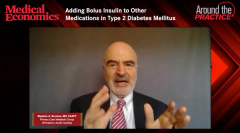
Benefits of an Insulin Pump for Type 2 Diabetes Mellitus
Episodes in this series

Dhiren Patel, PharmD, CDE, BC-ADM, BCACP: Dr Brunton, you can talk about it, and Diana, you can talk about it. When you’re talking to your patients—Diana, I know you’re more involved in starting it, but Steve, you may be saying, “I’m going to refer you,” but you sit down and have a conversation. Most of the patients I’m seeing are eager, or they at least want to learn more about the pump. If we may be thinking about some other types of therapy, there’s a bit more selling that we need to do. When you’re talking to a patient regarding an insulin pump, what are some of the benefits you give when you talk to them and say, “I’m going to send you a referral. I want you to go see an endocrinologist. I want you to go see a CDE [certified diabetes educator]. They’re going to sit down, talk with you, and figure out if this is really right for you.” Diana, when you do sit down, what are some of the things that you then try to instill into the conversation at that point?
Stephen A. Brunton, MD, FAAFP: To your point, there are patients who often hear about it even when we don’t even bring up, so it’s once again asking them what they’ve heard about a pump and working with that information. That’s always the best way to go. If they haven’t heard it, and they’re on multiple insulin injections, particularly if they’re finding inconvenience of that, those patients from my viewpoint are ideal. Fortunately, in terms of the extension of the education, the manufacturers will usually have an educator involved who can help work to both introduce the patient to it and show them how to use it. It’s not something that has to be done alone. Once again, your diabetes educator becomes critical in that fine-tuning aspect. It’s a question that some of these patients will declare themselves. They’re having trouble maintaining a regular schedule. They’re not bringing their insulin with them.
Dhiren Patel, PharmD, CDE, BC-ADM, BCACP: Sure.
Stephen A. Brunton, MD, FAAFP: With the convenience of this, I’ll talk about convenience and having a normal life. It’s also becoming a misconception. Diana said that: “Oh my God, I have to have a pump. I must be really ill.” We say, “No, this is a way of making your life function a lot easier.”
Dhiren Patel, PharmD, CDE, BC-ADM, BCACP: Sure.
Diana Isaacs, PharmD, BCPS, BCACP, BC-ADM, CDCES: Yes, and there is a lot. Usually, at the initial training, we’re doing the basics: teaching them how they use it and how they use bolus insulin, and that in itself offers a lot of conveniences because they don’t have to remember to carry that vial or that insulin pen. It’s on them all the time. They can press a button and give themselves a dose of bolus insulin with their meal or with their snack. It can be very discreet. They can hide the pump and keep it in their pocket. No one has to know they’re wearing it if they don’t want to share it.
There are also a lot cool things you can do with it. We have integration with CGM [continuous glucose monitoring]. But it could even be other things, like if a person is going to exercise, they’re usually worried about going low. In the past, they may have had to eat extra snacks and things to prevent going low, but with pumps, you can do things like temporary basal insulin. You can suspend the background insulin; you can decrease it to a certain amount. There are also things with higher-fat meals. Let’s say you’re going to be grazing for a long time, like if you’re at a 3-hour meal. You can do extended bolus insulin doses. There are so many cool tips and tricks. Granted, some people are really into it, and some just say, “Show me the simple stuff.” We can customize it, and there’s a lot you can do.
Newsletter
Stay informed and empowered with Medical Economics enewsletter, delivering expert insights, financial strategies, practice management tips and technology trends — tailored for today’s physicians.











